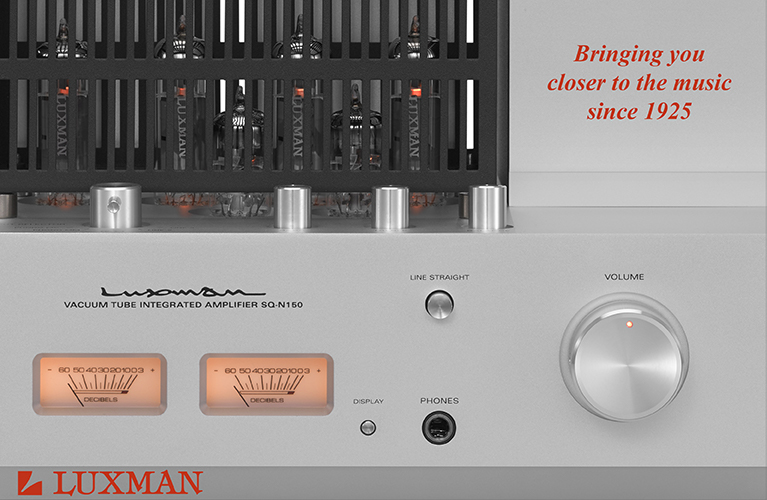Note: Measurements can be found through this link.
 I think one can fairly generalize that audiophiles are obsessive. We know how we want our stereos to sound, and we sometimes go to great lengths in tweaking them to achieve that sound. Often, attaining the desired result means a years-long process of swapping out components. For some, it means buying a separate component for each function -- DAC, phono stage, preamplifier, amplifier, etc. -- resulting in multiple links in the audio-signal chain where the system’s sound can be tuned. I am one of these obsessives, because I care about sound quality -- if I didn’t, I wouldn’t be writing this review.
I think one can fairly generalize that audiophiles are obsessive. We know how we want our stereos to sound, and we sometimes go to great lengths in tweaking them to achieve that sound. Often, attaining the desired result means a years-long process of swapping out components. For some, it means buying a separate component for each function -- DAC, phono stage, preamplifier, amplifier, etc. -- resulting in multiple links in the audio-signal chain where the system’s sound can be tuned. I am one of these obsessives, because I care about sound quality -- if I didn’t, I wouldn’t be writing this review.
But I’ve never really wanted to own many components. At first, my reason for this was very convincing: I couldn’t afford them. However, I’ve since heard some top-flight integrated amplifiers, and have come to realize that I can enjoy a quality of sound that’s pretty close to that offered by high-quality separates, but from a simpler and less-expensive package -- and the fact that all functions are contained in a single enclosure offers the benefit of shorter signal paths. I’m hardly alone -- several other writers here at the SoundStage! Network now eschew separates in favor of one-box electronics.
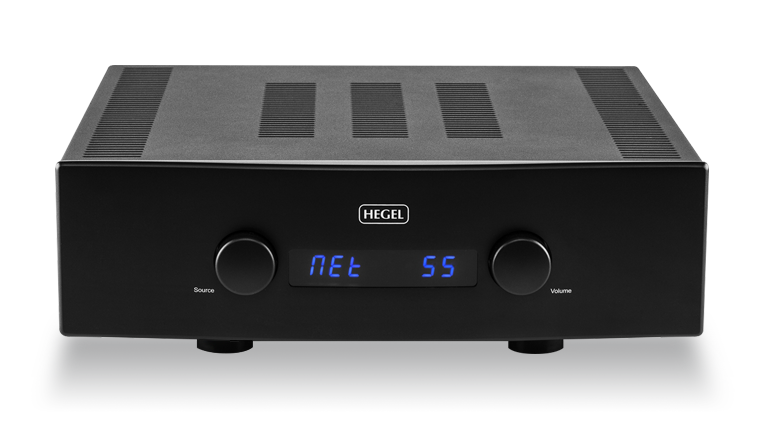
Reviewers often -- perhaps too often -- liken integrated amplifiers to the proverbial Swiss Army Knife, and the simile is apt: a single, compact case containing multiple tools for different uses. But while a Swiss Army Knife’s fold-out scissors could never rival a pair of full-size utility scissors, a well-designed integrated amp can approach the performance of separates. I wondered if Hegel Music Systems’ H360 ($5700 USD) -- a single enclosure containing a DAC, preamplifier, power amplifier, and music streamer -- might be one of them.
Description
The H360 replaces the H300 as Hegel’s top model of integrated amplifier. Like its predecessor, the H360 boasts a whopping 250Wpc into 8 ohms, or 420Wpc into 4 ohms. Its damping factor is over 4000 -- four times that of the H300. It should have no difficulty driving just about any pair of speakers it’s hooked up to.
The H360 is a dual-mono amplifier, with entirely separate gain stages and independent power supplies for each channel. Other than sharing a single power transformer, this is the equivalent of putting two mono amplifiers in one box. This approach costs more -- all parts must be duplicated and ideally matched -- but it’s also claimed to offer better channel separation, as none of the components used to build each amplifier module are shared between channels.
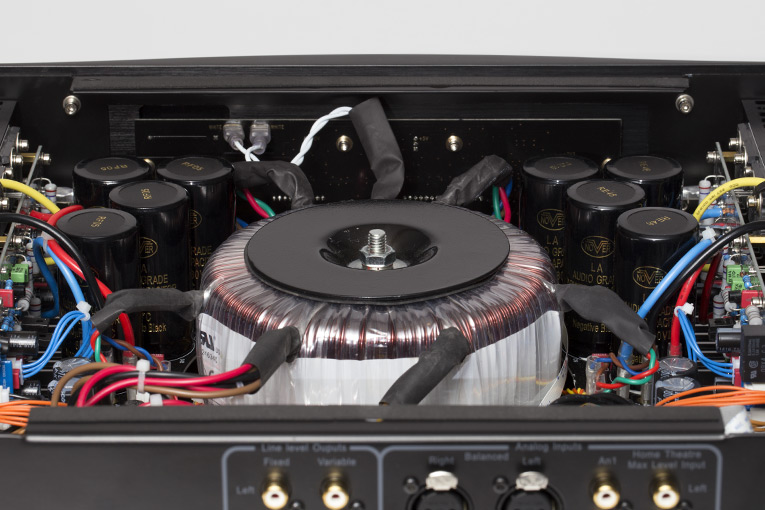
Like all Hegel amplifiers, the H360 includes the Norwegian company’s patented SoundEngine technology. Hegel describes this as a local error-canceling system whose purpose is to eliminate the crossover distortion found in many class-AB amplification circuits. To remove high-frequency distortion, SoundEngine uses what Hegel calls local and adaptive feed-forward technology, to produce a cleaner musical signal with greater dynamic range.
Weighing just over 45 pounds and measuring 16.9”W x 5.9”H x 16.9”D, the H360 feels substantial. Just looking at it, however, you’d be forgiven for underestimating all that it can do. Instead of buttons, on the front panel are only two knobs, for Source and Volume, and, between them, a small screen that displays the source selected and the volume setting. I like the minimalist appearance: clean and simple, it should go well with most décors.
On the rear panel are just three analog inputs: one balanced (XLR), two unbalanced (RCA). One of the unbalanced inputs is fixed as a high-level output for home theater, but this can be changed to a standard analog input using the supplied remote control. While three analog inputs is fairly modest for a component that retails for $5700, it’s more than enough for anyone who wants to use the Hegel’s onboard DAC or connect the H360 to an external DAC. That’s why there are no fewer than six digital inputs: three optical, one coaxial, one USB, and one network (Ethernet). The network input can be connected to your router and used to play music from your library using an AirPlay-compatible device. Additionally, the H360 can be used as a DLNA renderer, to receive and play files from a UPnP/DLNA-compatible media player. Given that many people now store and listen to their music directly from a digital library, this is a nice feature I haven’t seen on any other integrated amplifier I’ve reviewed.
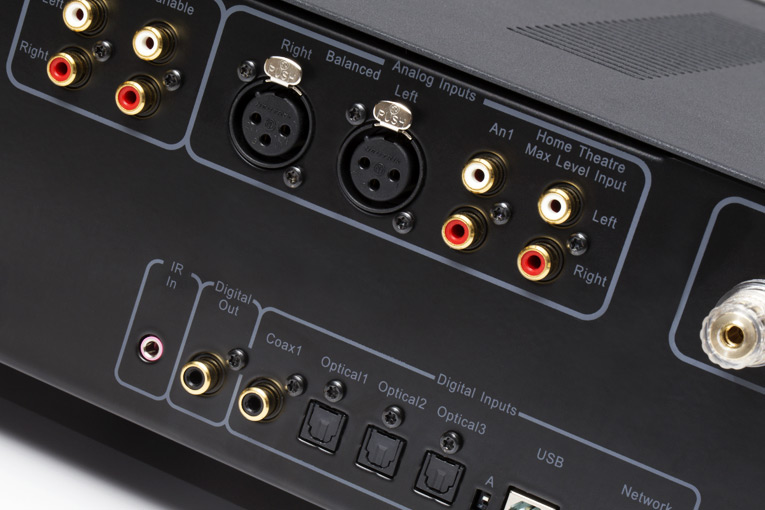
The H360’s DAC uses an AKM AK4450 chip and features a new master clock that reclocks all incoming digital signals, to reduce jitter. The AKM chip can accept signals of resolutions up to 24-bit/192kHz for each input, while the asynchronous USB input can accept native DSD64/128 signals. This is an improvement over the Hegel H300’s onboard DAC, which could accept only PCM data.
If you already own a high-end DAC, Hegel hasn’t forgotten you. The H360 includes a DAC loop that still reclocks all incoming digital signals, before sending them to your external DAC through a digital coaxial output. The reclocked data is converted by your external DAC and sent back to the Hegel through one of its analog inputs.
The H360 has a few nice features worth noting. For example, when I first connected it, I hadn’t yet read the manual; I plugged my TV into the input fixed as a high-level output (aka a home-theater bypass). By default, the volume setting for this input is “85” (the H360’s maximum volume is “99”) -- when I switched on the TV, the sound could have been deafening. Fortunately, Hegel’s engineers had anticipated that someone might do this; rather than play at near-maximal output instantaneously, the H360 slowly ramps up the volume. This gave me ample time to switch to an unused input before my speakers were damaged. Disaster avoided.
The H360 can also be programmed to have a user-defined power-up volume to which it will always default when turned on, as well as a maximum volume level -- with the latter, it will be impossible to accidentally turn the volume up too high, and risk harming your ears and/or speakers.
A design detail I’m not sure I’d ever come across before: The Hegel’s power switch is on its bottom panel, at the front -- you don’t have to reach around back to switch it on or off. If you keep your components in a cabinet, you’ll appreciate this.

The supplied remote handset is Hegel’s universal model: It controls not only the H360 but any Hegel preamplifier, CD player, or DAC. Made entirely of aluminum, it felt solid in the hand. The buttons, small but well spaced, responded reliably.
Sound
The Hegel H360 replaced a Bryston B135 SST2 integrated amplifier as the backbone of my system. I connected it to a pair of Revel Performa3 F206 floorstanding speakers with AudioQuest Comet cables terminated in banana plugs. An NAD C 565BEE CD player and an Apple MacBook running Audirvana formed the digital front end, these connected to a Bryston BDA-2 DAC via, respectively, an i2Digital X-60 digital coaxial cable and an AudioQuest Forest USB cable. I used another X-60 to connect the NAD’s digital output directly to the H360’s digital coaxial input, so I could experiment with the Hegel’s DAC. In this case, the CD player was connected to the Bryston DAC with an AMX Optimum optical link. LPs were played on a Thorens TD-160HD turntable fitted with a Rega Research RB250 tonearm and a Dynavector DV-10X5 high-output moving-coil cartridge, all feeding a Lehmann Audio Black Cube SE phono stage. All electronics were plugged into an ExactPower EP15A power conditioner/regenerator.
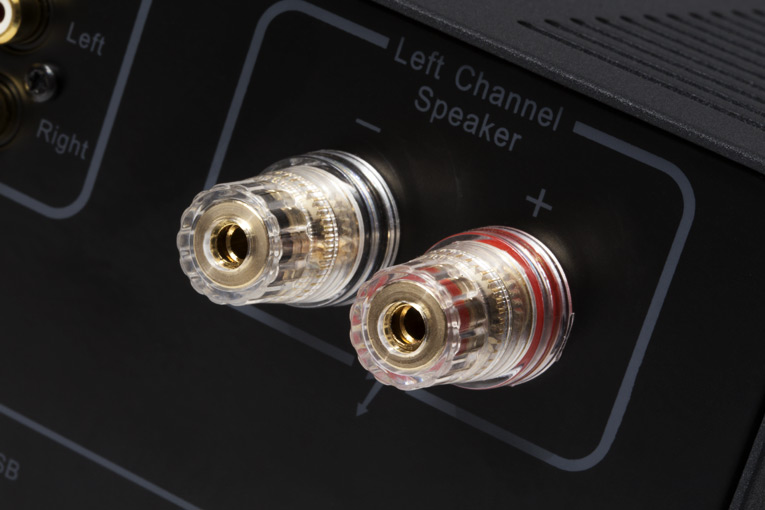
Before I received the review sample of the H360, Doug Schneider (and possibly others) had already listened to it -- I figured it must by now be fully broken in, and as I heard no change in its sound during the entire listening period, it seems that it was. I settled into my chair and began playing music. Through Bryston’s BDA-2 DAC, it quickly became clear that the H360 was an ultra-clean-sounding integrated amp. If you prefer transparent, low-noise amplification, you’ll find plenty to admire in the H360.
Listening to the H360 reminded me of the first time I heard Bryston’s B100 SST integrated, nearly a decade ago. Similarities of sound aside, this was also due to the fact that the first album I played through both models was Tori Amos’s Boys for Pele (CD, EastWest A2 82862). I’ve cited Amos’s recordings in my reviews for almost as long as I’ve been writing for SoundStage! because they tend to be well produced, and are especially notable for the close miking of her voice, which creates a more intimate listening experience.
In “Beauty Queen,” the music emerged from a “black” background that drew sharp focus to Amos’s voice and the rich tone of her Bösendorfer acoustic piano. There’s an inherent forwardness to this track, and the Hegel ably revealed every nuance of it, particularly the dynamic range of the piano, whose sparkling upper registers provided the perfect contrast to its powerful and weighty bottom end.
The H360’s noise floor was so low that it encouraged me to take liberties with the volume level -- as I turned it up, it just sounded so darn clean. I could have fun energizing my listening room without the distortion artifacts produced by lesser integrateds. I especially enjoyed hearing Amos’s “Professional Widow” and “Caught a Lite Sneeze” through the übertidy Hegel -- even in these tracks’ explosive moments, the music always remained composed.
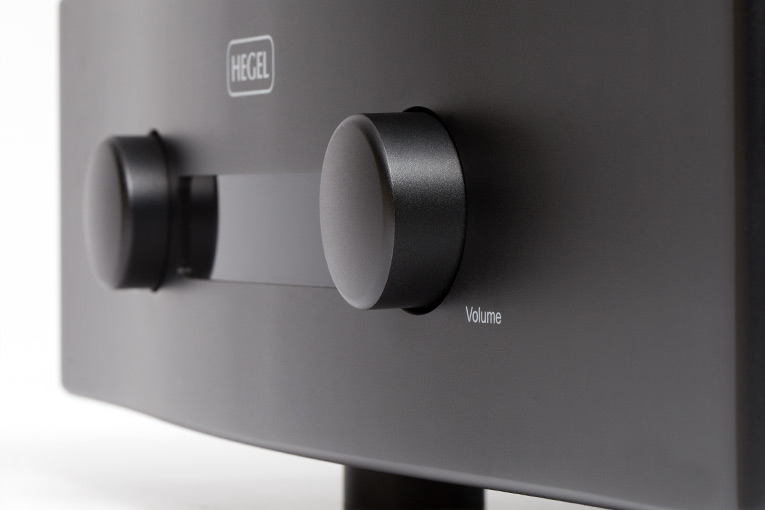
Because the H360 produced such dead-silent backgrounds, I wanted to hear its reproduction of Mahler’s Symphony No.5, in the performance by the St. Petersburg Philharmonic Orchestra led by Yuri Temirkanov (SACD/CD, Water Lily Acoustics WLA-WS-76 SACD). My relatively small collection of classical music has a disproportionately large number of high-quality recordings, but this disc stands out as one of the most natural sounding. Even the best stereos in the world can’t replicate in my or anyone’s home the sound of a live performance -- if you think otherwise, you need to hear more live music -- but the H360 was so transparent that it did a fine job of capturing the grand acoustic of the Great Hall of the St. Petersburg Philharmonic making it easy to imagine myself sitting in the audience and enjoying the concert. Through the Hegel H360 the soundstage was broad and clearly defined, with a tangible sense of depth that allowed me to envision the performance unfolding at the front of my room. Even the sounds of audience members coughing were further testament to the uneditorialized nature of the recording -- such details were so clearly rendered by the H360 that they became as distracting as when heard in person at a concert. I mention this as a criticism of neither the Hegel nor live concerts, but as precisely the type and level of detail that makes listening to so fine a recording all the more authentic.
Electronics with such low noise floors generally have a wide dynamic range -- low-level details are more audibly rendered, thereby expanding the difference between the quietest and loudest passages. Stephan Ganz’s recital of lieder by Beethoven, with pianist Roger Vignoles (CD, Hyperion GAW21055), isn’t nearly as dynamically explosive as the War Dance from Respighi’s Belkis, Queen of Sheba: Suite, with Eiji Oue conducting the Minneapolis Symphony (CD, Reference RR95CD), but the power of Ganz’s baritone was fully demonstrated in “An die Hoffnung.” The H360’s crystalline clarity was undeniable, conveying in equal measure Ganz’s articulations and emotional emphases and the decays of the piano’s strings, and thus offering a clear window on the music making.
I moved on to a very different baritone. The Hegel’s reproduction of Tom Waits’s distinct voice was beyond reproach. With “Take It With Me,” from Mule Variations (CD, Anti-/Epitaph 86547-2), the H360 was the very embodiment of neutrality, adding to the sound no character of its own. The midrange was open and pure -- I was simply engrossed in the music. Waits’s upright piano is nicely recorded, but it’s his rough, well-worn voice that takes center stage and breathes life into this song. The level of detail captured by the Hegel was remarkable -- I was left with the impression that this track probably couldn’t sound much better in my room.
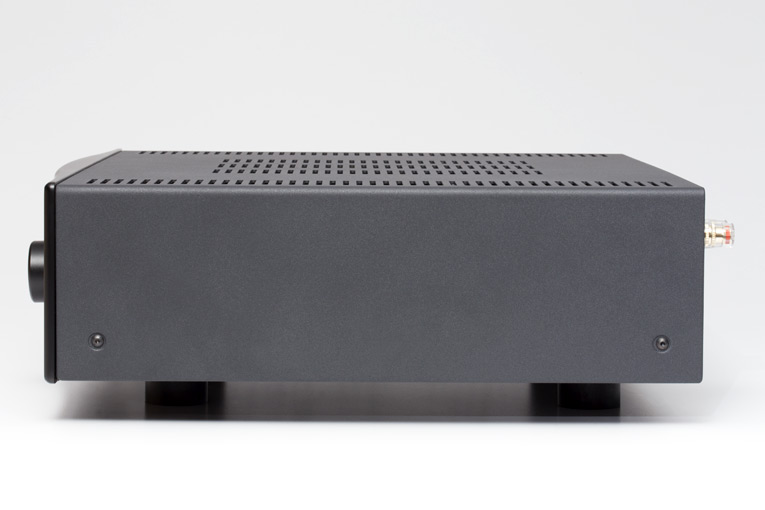
With 250Wpc at its disposal, the H360 conveyed a sense of effortlessness with everything I played. As I listened to “Hustleblood,” from Big Boi’s Sir Lucious Left Foot: The Son of Chico Dusty (CD, Def Jam B001437702), the Hegel maintained rock-solid control over the Revel F206es’ woofers, delivering tight bass that never ventured into sounding fat or boomy. On their own, the F206es are disciplined speakers that offer no bloat in their lowest registers; they and the Hegel made a formidable trio that neither exaggerated nor diminished anything in the music. The amp exerted firm control over the speakers -- the sound was so clean that I found myself turning up the volume.
I also spent time listening to the H360’s onboard DAC. Perhaps unsurprisingly, I found that its sound mirrored that of the amplifier. Dead quiet in operation, it was highly revealing and offered a clear window on my music collection, with little character of its own -- in short, it sounded neutral. Low-level details were well resolved, spatial information lucidly rendered. Its sound was similar to that of the Bryston BDA-2 -- high praise, given that that DAC sells for $2395 on its own. With “Youlogy,” from Shabazz Palaces’ Black Up (CD, Sub Pop 98787 09002), the H360’s DAC was a bit more upfront and lively than the BDA-2. I found I was happy with whichever converter I was using -- a sure sign of their similarity and, more important, their high levels of performance.
I was writing this article as Christmas approached, and listened to “God Rest Ye Merry, Gentlemen” from Yuletide Fires, by the Vancouver-based men’s choir Chor Leoni (CD, Cypress Choral CCR0601). However, other than the additional gain offered by the H360, I heard no difference between it and the BDA-2. Again, these are both refined and highly resolving DACs; it is a testament to the Hegel that its built-in DAC compared so favorably with an outboard DAC costing $2395.
Comparison
My reference integrated amplifier is a Bryston B135 SST2, and at $4695, it’s in direct competition with the Hegel H360. It doesn’t come standard with an onboard DAC or remote control, but these can be added for $1395 and $375, respectively, bringing the total package price to $6465 -- $765 more than the H360. The difference isn’t trivial, but the Bryston comes with a 20-year warranty -- more than six times longer than the H360’s three years.
Like the H360, the B135 SST2 is a dual-mono design, but is specified to deliver 135Wpc into 8 ohms or 180Wpc into 4 ohms. It has six line-level inputs (there is no balanced input), or five if the optional DAC is included. There are four digital inputs for the DAC itself, but, unlike the H360, no USB input. Furthermore, the Bryston has no built-in networking capabilities.
Before comparing the Hegel and Bryston integrateds, I reconnected the Bryston BDA-2 DAC. Sonically the H360 and B135 weren’t quite identical twins, but both sounded ultraclean, and should appeal to listeners for whom transparency is at or near the top of the list of priorities. Given how close they are in sound quality and price, anyone considering buying one should try to hear both.
I spent a fair amount of time listening to “Hustleblood” through both amps. Both delivered impeccably clean renditions of this well-produced R&B/hip-hop track, but I found the H360 a touch more transparent than the B135. Their soundstage widths were about the same, but the Hegel gave a slightly clearer picture of the space within that stage, which also seemed a bit deeper. The bass in “Hustleblood” digs pretty deep -- it even sounds fat through some speakers -- but the Hegel delivered it with excellent clarity that easily resolved such details as the decays of the lowest notes. But as good as the H360 was, the B135 sounded a tad more powerful, generating bass that hit with a bit more impact.
Curious how the Hegel and Bryston would compare with a good-quality vocal recording, I returned to Tori Amos, this time the a cappella “Me and a Gun,” from her debut album, Little Earthquakes (CD, EastWest 82358). Once again, the two amps sounded strikingly similar, with one difference: Amos’s voice sounded slightly tighter and more focused through the H360. Even so, I had to switch back and forth between the amps several times to be sure of what I was hearing.
In saying that the Hegel H360 sounded more transparent than the Bryston B135 SST2, I’m not suggesting that you’ll hear details through the former that you won’t hear at all through the latter. The difference was subtle, tending to manifest itself as, say, a clearer sense of space within the music. Both integrateds did this exceptionally well; the Hegel did it slightly better.
The Norwegian and Canadian amps were also closely matched in terms of bass reproduction: both were clean and disciplined in the low end, but the Bryston seemed a touch more powerful. I suspect that, for some, the decision of which to buy may be more a matter of price and/or features. Otherwise, I don’t believe you can make a bad choice. If you have a larger room or more power-hungry speakers, the Hegel’s additional power might better suit; but both of these muscular amps delivered far more power than I could use in my medium-size room.
Conclusion
I noted in my introduction that integrated amplifiers are often likened to the Swiss Army Knife, but after spending time with the Hegel H360, I think a Leatherman knife is more apt. Leatherman knives, their design based on a pair of pliers instead of a jackknife, drastically improve on the concept of the Swiss Army Knife with sturdier, more functional tools. With the H360, Hegel hasn’t exactly changed the concept of the integrated amplifier, but they’ve expanded it by including a high-end onboard DAC, networking capability, and sound quality that is among the best I’ve heard from an integrated package.
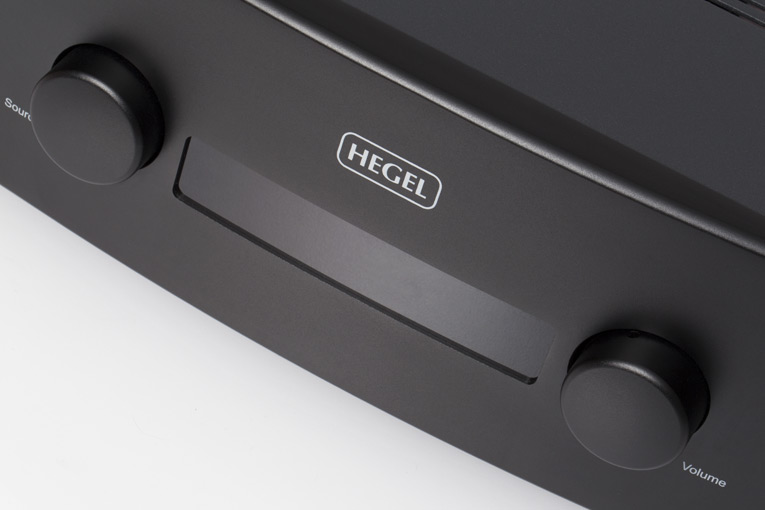
While some audiophiles may view integrated amplifiers as merely a compromise for those who lack the money or space for separates, this idea is becoming outdated, and there’s no better example of how much things have changed than Hegel’s new H360. It’s packed with features, extremely well built, and has a nice, unassuming design. Most important, its superclean sound and transparency will appeal to those many music lovers who crave detail and resolution. If you’ve got the money, you can’t go wrong with the Hegel Music Systems H360.
. . . Philip Beaudette
philipb@soundstagenetwork.com
Associated Equipment
- Speakers -- Amphion Argon3L, Revel Performa3 F206
- Integrated amplifier -- Bryston B135 SST2
- Digital sources -- Apple MacBook computer running Audirvana, Bryston BDA-2 DAC, NAD C 565BEE CD player
- Speaker cables -- AudioQuest Comet
- Interconnects -- Kimber Kable Tonik
- Digital interconnects -- AudioQuest Forest USB, i2Digital X-60 coaxial
- Power conditioner -- ExactPower EP15A
Hegel Music Systems H360 DAC-Integrated Amplifier
Price: $5700 USD.
Warranty: Three years parts and labor.
Hegel Music Systems AS
PO Box 2, Torshov
NO-0412 Oslo
Norway
Phone: +47 22-60-56-60
Fax: +47 22-69-91-56
E-mail: info@hegel.com
Website: www.hegel.com
North American distributors:
USA
Hegel USA
East Longmeadow, MA
Phone: (413) 224-2480
E-mail: usa@hegel.com
Website: www.hegel.com
Canada
Hegel Canada
CP 8, Westmount Station
Montreal, QC H3Z 2T1
Phone: (514) 931-1880
Fax: (866) 708-1352
E-mail: richard@hegel.com






















